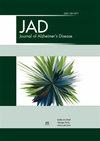手握力弱和不对称与认知功能低下的关系:国家健康与营养调查(2011-2014 年)的结果
IF 3.4
3区 医学
Q2 NEUROSCIENCES
引用次数: 0
摘要
背景:在老年人中,手握力(HGS)薄弱和不对称与认知能力下降之间的关系仍未得到充分研究。目的: 研究手握力弱、不对称和认知能力下降之间的关系:在具有全国代表性的美国老年人样本中调查手握力弱、不对称与认知功能下降之间的关系。方法: 采用横断面研究方法:这项横断面研究利用了 2011-2014 年全国健康与营养调查的数据。HGS比率为1.10的人被归类为HGS不对称。HGS 比率大于 1.10 的人表现为优势 HGS 不对称,而 HGS 比率小于 0.90 的人则表现为非优势 HGS 不对称。认知功能低下的定义是全球认知综合评分低于平均值 1 个标准差以上。采用协变量调整的逻辑回归模型分析 HGS 不对称/弱与认知功能低下之间的关联。结果显示与HGS不对称和对称的个体相比,单独存在HGS不对称和单独存在HGS虚弱的个体出现认知功能下降的几率分别为1.017(95% 置信区间[CI]:0.707-1.463)和1.391(95% CI:0.542-3.571),而同时存在HGS不对称和虚弱的个体出现认知功能下降的几率为3.724(95% CI:1.711-8.107)。结论:同时表现出HGS减弱和不对称的个体对认知功能损害的易感性更高,这意味着将HGS不对称评估与虚弱评估结合起来可能会提高认知功能衰退预后的准确性。本文章由计算机程序翻译,如有差异,请以英文原文为准。
Associations of Handgrip Strength Weakness and Asymmetry with Lower Cognitive Function: Results from the National Health and Nutrition Examination Survey (2011–2014)
Background: The joint associations of handgrip strength (HGS) weakness and asymmetry with cognitive decline remain understudied in older adults. Objective: To investigate the associations between HGS weakness, asymmetry, and lower cognitive function in a nationally representative sample of older Americans. Methods: This cross-sectional study utilized data from the National Health and Nutrition Examination Survey 2011–2014. Weakness was defined as HGS <26 kg for men and <16 kg for women. Asymmetry was determined by calculating the ratio of dominant to non-dominant HGS. Participants with an HGS ratio <0.90 or >1.10 were classified as having any HGS asymmetry. Those with an HGS ratio >1.10 exhibited dominant HGS asymmetry, while those with an HGS ratio <0.90 displayed nondominant HGS asymmetry, respectively. Lower cognitive functioning was defined as global cognitive composite scores more than 1 standard deviation below the mean. Covariate-adjusted logistic regression models were used to analyze the associations between HGS asymmetry/weakness and lower cognitive functioning. Results: Compared to individuals with non-weak and symmetric HGS, those with any HGS asymmetry alone and weakness alone had 1.017 (95% confidence interval [CI]: 0.707–1.463) and 1.391 (95% CI: 0.542–3.571) greater odds for cognitive decline, while co-occurrence of both HGS asymmetry and weakness was associated with 3.724 (95% CI: 1.711–8.107) greater odds for lower cognitive function after controlling for confounders. Cnclusions: Individuals exhibiting both diminished and asymmetrical HGS demonstrated an elevated susceptibility to cognitive impairment, thereby implying that the inclusion of HGS asymmetry assessment in conjunction with weakness evaluation may enhance the accuracy of prognosticating cognitive decline.
求助全文
通过发布文献求助,成功后即可免费获取论文全文。
去求助
来源期刊

Journal of Alzheimer's Disease
医学-神经科学
CiteScore
6.40
自引率
7.50%
发文量
1327
审稿时长
2 months
期刊介绍:
The Journal of Alzheimer''s Disease (JAD) is an international multidisciplinary journal to facilitate progress in understanding the etiology, pathogenesis, epidemiology, genetics, behavior, treatment and psychology of Alzheimer''s disease. The journal publishes research reports, reviews, short communications, hypotheses, ethics reviews, book reviews, and letters-to-the-editor. The journal is dedicated to providing an open forum for original research that will expedite our fundamental understanding of Alzheimer''s disease.
 求助内容:
求助内容: 应助结果提醒方式:
应助结果提醒方式:


